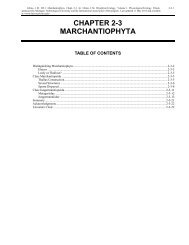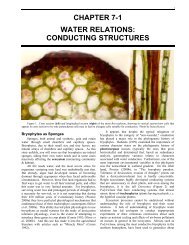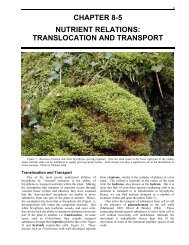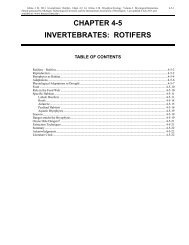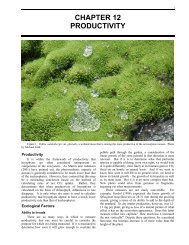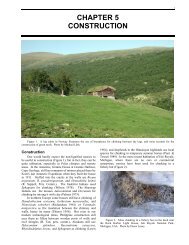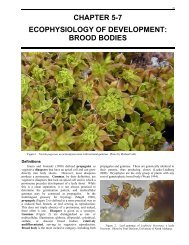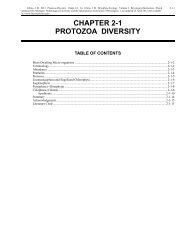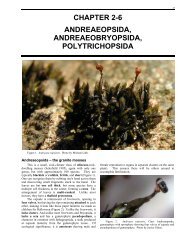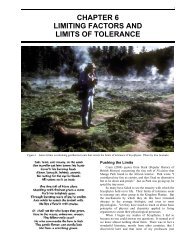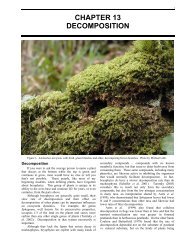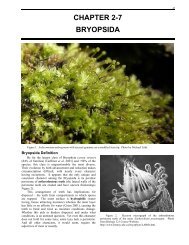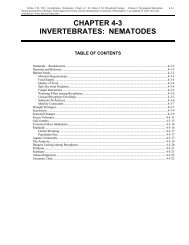Chapter 4-6 Invertebrates Mollusks - Bryophyte Ecology
Chapter 4-6 Invertebrates Mollusks - Bryophyte Ecology
Chapter 4-6 Invertebrates Mollusks - Bryophyte Ecology
Create successful ePaper yourself
Turn your PDF publications into a flip-book with our unique Google optimized e-Paper software.
<strong>Chapter</strong> 4-6: <strong>Invertebrates</strong>: <strong>Mollusks</strong> 67(Symondson 2004). Some of these beetles use a pumpmechanism to extract the gastropod remains from its shell.In streams, it is likely that snails find mosses as a safesite from the current. Habdija et al. (2004) rarely foundany gastropods on bryophytes at velocities of greater than70 cm s -1 , whereas oligochaetes became more abundant athigher velocities. Flow rates are much slower within themoss mats, thus providing a haven for feeding where thecurrent is unlikely to dislodge the snails and slugs. Thisalso provides them protection from predators such as fish(mostly), ducks, shore birds, and amphibians (Pennak1953).Figure 5. Monadenia fidelis on mosses. Photo by WalterSiegmund through Wikipedia.Figure 7. Prophysaon vanattae, the scarletback taildropper,can be found hiding under mosses. Photo by Kristiina Ovaska.Figure 8. Prophysaon vanattae with eggs on a moss. Photoby Kristiina Ovaska.Figure 6. Laboratory selection of foods by the snailMonadenia hillebrandi mariposa. Upper: all data combined.Lower: juveniles vs adults. Redrawn from Szlavecz 1986.The slug Prophysaon vanattae (scarletbacktaildropper; Figure 7) is one of those snails that seems tofind a safe site under mosses on trees on Vancouver Island,Canada (Kristiina Ovaska, pers. comm. 30 June 2009). Butit also hangs on epiphytic moss mats in the moist deciduousforest there and may even lay eggs there (Figure 8).<strong>Bryophyte</strong>s as FoodSnails and slugs have a rasping tongue that destroysthe epidermis of tracheophytes (Grime & Blythe 1969), butwhat does it do to moss leaves only one cell thick?Apparently it makes them potential food (Szlavecz 1986),enabling these mollusks to consume even the tough capsule(Davidson & Longton 1987, Davidson et al. 1990).Nevertheless, the palatability index for bryophytes is low(Jennings & Barkham 1975). And snails and slugs seem tobe less interested in grazing things with awns than thosewithout. Robin Stevenson (pers. comm. January 2008;Figure 9) has seen Bryum argenteum that is completelygrazed over, but never observed such grazing on an awnedGrimmia species. Could it just be that there is no nutritionin an awn, or do they have trouble gliding across the furrytips of leaves?But awns may not deter all snails. Szlavecz (1986)was able to identify the awned Grimmia trichophylla in thefeces of the California snail, Monadenia hillebrandimariposa and also demonstrated that the spine tips of thetracheophyte Selaginella hanseni did not deter feeding orcrawling. Michael Lüth has observed snails grazing on
<strong>Chapter</strong> 4-6: <strong>Invertebrates</strong>: <strong>Mollusks</strong> 75Gerson, U. 1982. <strong>Bryophyte</strong>s and invertebrates. In: Smith, A. J.E. (ed.). <strong>Bryophyte</strong> <strong>Ecology</strong>. Chapman & Hall, New York,pp. 291-332.Grime, J. P. 1979. Plant Strategies and Vegetation Processes.Wiley, Chichester.Grime, J. P. and Blythe, G. M. 1969. An investigation of therelationships between snails and vegetation at the WinnatsPass. J. Ecol. 57: 45-66.Habdija, I., Primc Habdija, B., Matoničkin, R., Kučinić, M.,Radanović, I., Miliša, M., and Mihaljević, Z. 2004. Currentvelocity and food supply as factors affecting the compositionof macroinvertebrates in bryophyte habitats in karst runningwater. Biologia Bratislava 59: 577-593.Jennings, T. J. and Barkham, J. P. 1975. Food of slugs in mixeddeciduous woodland. Oikos 26: 211-221.Kimmerer, R. W. and Young, C. C. 1995. The role of slugs indispersal of the asexual propagules of Dicranum flagellare.Bryologist 98: 149-153.Leonard, W. and Ovaska, K. 2003. Jumping-Slugs!. Wings26(1): 9-13, 17.Lohammar, G. 1954. The distribution and ecology of Fissidensjulianus in northern Europe. Svensk Bot. Tidskr. 58: 162-173.Merrifield, K. 2000. <strong>Bryophyte</strong>s on isolated Quercus garryanatrunks in urban and agricultural settings in the WillametteValley, Oregon. Bryologist 103: 720-724.Merrifield, K. and Ingham, R. E. 1998. Nematodes and otheraquatic invertebrates in Eurhynchium oreganum (Sull.) Jaeg.,from Mary's Peak, Oregon Coast Range. Bryologist 101:505-511.Nekola, J. C. 2002. Distribution and <strong>Ecology</strong> of TerrestrialGastropods in Northwestern Minnesota. Final Report: 2001-2002 Natural Heritage and Nongame Research Program,Division of Fish and Wildlife, Minnesota Department ofNatural Resources, St. Paul, Minnesota.Neumann, A. J. and Vidrine, M. F. 1978. Occurrence ofFissidens fontanus and Leptodictyum riparium on freshwatermussels. Bryologist 81: 584-585.Nyffeler, M. and Symondson, W. O. C. 2001. Spiders andharvestmen as gastropod predators. Ecol. Entomol. 26: 617-628.Ochi, H. 1960. Conocephalum conicum, as a food for a slug.Hikobia 2: 154-155.Oyesiku, O. O. and Ogunkolade, O. R. 2006. The relationshipbetween the Nigerian garden snail Limicolaria aurora andthe moss Hyophila crenulata. J. Bryol. 28: 104-107.Pennak, R. W. 1953. Fresh-water <strong>Invertebrates</strong> of the UnitedStates. Ronald Press Co., N. Y., 769 pp.Pratt, H. S. 1935. A Manual of the Common InvertebrateAnimals. McGraw-Hill Book Co., Inc., New York, p. 572.Richter, K. O. 1976. The foraging ecology of the banana slugAriolimax columbianus Gould (Arionidae). Ph. D.Dissertation, University of Washington, Seattle.Rosso, A. L. and McCune, B. 2003. Exploring the effects ofmollusk herbivory on an epiphytic lichen community.Evansia 20: 15-30.Shachak, M. and Steinberger, Y. 1980. An algae - desert snailfood chain: Energy flow and soil turnover. Oecologia 46:402-411.Smith, V. R. 1992. Terrestrial slug recorded from sub-AntarcticMarion Island. J. Molluscan Studies 58: 80-81.Stanisic, J. 1996. New land snails from boggomoss environmentsin the Dawson Valley, southeastern Queensland(Eupulmonata: Charopidae and Camaenidae). Memoirs ofthe Queensland Museum. 39: 343-354.Stark, R. M. 1860. A Popular History of British Mosses. GeorgeRoutledge, London, p. 8.Steinman, A. D. 1994. The influence of phosphorus enrichmenton lotic bryophytes. Freshwat. Biol. 31: 53-63.Stolzenburg, W. 1995. Partners in slime. Nature ConservancySept/Oct: 7.Symondson, W. O. C. 2004. Coleoptera (Carabidae,Staphylinidae, Lampyridae, Drilidae and Silphidae) aspredators of terrestrial gastropods. In: Barker, G. M. (ed.).Natural Enemies of Terrestrial Molluscs. CABI Publishing,pp. 37-84.Szlavecz, K. 1986. Food selection and nocturnal behavior of theland snail Monadenia hillebrandi mariposa A. G. Smith(Pulmonata: Melminthoglyptidae). Veliger 29: 183-190.Varga, J. 2008. Analysis of the bryofauna of some moss species.Науковий вісник Ужгородського університету СеріяБіологія, Випуск 23: 264-265.Wiesenborn, W. D. 2003. White desertsnail, Eremariontaimmaculata (Gastropoda: Pulmonata), activity duringdaylight after winter rainfall. Southw. Nat. 48: 202-207.Williamson, P. and Cameron, R. A. D. 1976. Natural diets of thelandsnail, Cepaea nemoralis. Oikos 17: 493-500.Wurzel, G., Becker, H., Eicher, T., and Tiefensee, K. 1990.Molluscicidal properties of constituents from the liverwortRicciocarpos natans and of synthetic lunularic acidderivatives. Planta Med. 56: 444-445.Yom-To, Y. and Galun, M. 1971. Notes on the feeding habits ofthe desert snails Sphincterochila boissieri Charpentier andTrochoidea (Xerocrassa) seetzeni Charpentier. Veliger 14:86-89.
76 <strong>Chapter</strong> 4-6: <strong>Invertebrates</strong>: <strong>Mollusks</strong>



